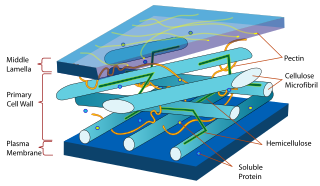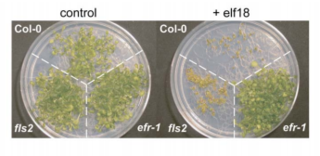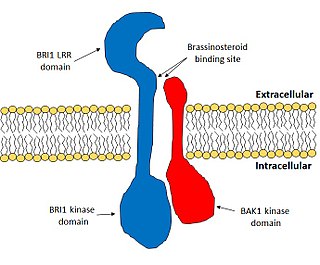Related Research Articles

Arabidopsis thaliana, the thale cress, mouse-ear cress or arabidopsis, is a small plant from the mustard family (Brassicaceae), native to Eurasia and Africa. Commonly found along the shoulders of roads and in disturbed land, it is generally considered a weed.
Flagellins are a family of proteins present in flagellated bacteria which arrange themselves in a hollow cylinder to form the filament in a bacterial flagellum. Flagellin has a mass on average of about 40,000 daltons. Flagellins are the principal component of bacterial flagella that have a crucial role in bacterial motility.
Pathogen-associated molecular patterns (PAMPs) are small molecular motifs conserved within a class of microbes, but not present in the host. They are recognized by toll-like receptors (TLRs) and other pattern recognition receptors (PRRs) in both plants and animals. This allows the innate immune system to recognize pathogens and thus, protect the host from infection.
Pattern recognition receptors (PRRs) play a crucial role in the proper function of the innate immune system. PRRs are germline-encoded host sensors, which detect molecules typical for the pathogens. They are proteins expressed mainly by cells of the innate immune system, such as dendritic cells, macrophages, monocytes, neutrophils, as well as by epithelial cells, to identify two classes of molecules: pathogen-associated molecular patterns (PAMPs), which are associated with microbial pathogens, and damage-associated molecular patterns (DAMPs), which are associated with components of host's cells that are released during cell damage or death. They are also called primitive pattern recognition receptors because they evolved before other parts of the immune system, particularly before adaptive immunity. PRRs also mediate the initiation of antigen-specific adaptive immune response and release of inflammatory cytokines.

The innate immune system or nonspecific immune system is one of the two main immunity strategies in vertebrates. The innate immune system is an alternate defense strategy and is the dominant immune system response found in plants, fungi, prokaryotes, and invertebrates.
Systemic acquired resistance (SAR) is a "whole-plant" resistance response that occurs following an earlier localized exposure to a pathogen. SAR is analogous to the innate immune system found in animals, and although there are many shared aspects between the two systems, it is thought to be a result of convergent evolution. The systemic acquired resistance response is dependent on the plant hormone, salicylic acid.

An immune complex, sometimes called an antigen-antibody complex or antigen-bound antibody, is a molecule formed from the binding of multiple antigens to antibodies. The bound antigen and antibody act as a unitary object, effectively an antigen of its own with a specific epitope. After an antigen-antibody reaction, the immune complexes can be subject to any of a number of responses, including complement deposition, opsonization, phagocytosis, or processing by proteases. Red blood cells carrying CR1-receptors on their surface may bind C3b-coated immune complexes and transport them to phagocytes, mostly in liver and spleen, and return to the general circulation.

Plant disease resistance protects plants from pathogens in two ways: by pre-formed structures and chemicals, and by infection-induced responses of the immune system. Relative to a susceptible plant, disease resistance is the reduction of pathogen growth on or in the plant, while the term disease tolerance describes plants that exhibit little disease damage despite substantial pathogen levels. Disease outcome is determined by the three-way interaction of the pathogen, the plant and the environmental conditions.
Ling Meng is a Chinese plant biologist in the Department of Plant and Microbial Biology at the University of California, Berkeley. She is currently a Postdoctoral Fellow at Lawrence Berkeley National Laboratory. She is best known for discovering a novel form of cellular communication in plants. Thioredoxin, while known to play an important role in biological processes such as cellular redox, is not fully understood in function. Meng's work at Berkeley has suggested that thioredoxin h9 is associated with the plasma membrane and is capable of moving from cell to cell through two important protein post-translation modifications: myristoylation and palmitoylation. She is the first to connect thioredoxin with the plasma membrane.
Lewis Jeffrey Feldman is a professor of plant biology at the University of California, Berkeley, Director of the University of California Botanical Garden and previously Associate Dean for Academic Affairs in the College of Natural Resources. He is in the Department of Plant and Microbial Biology. Feldman has taught at Berkeley since 1978. He received Berkeley's Distinguished Teaching Award in 1996. Feldman's research focuses on regulation of development in meristems/stem cells, root gravitropism, and redox regulation of plant development.
BRI1-associated receptor kinase 1 is an important plant protein that has diverse functions in plant development.
Jane Elizabeth Parker is a British scientist who researches the immune responses of plants at the Max Planck Institute for Plant Breeding Research.

Integrin-like receptors (ILRs) are found in plants and carry unique functional properties similar to true integrin proteins. True homologs of integrins exist in mammals, invertebrates, and some fungi but not in plant cells. Mammalian integrins are heterodimer transmembrane proteins that play a large role in bidirectional signal transduction. As transmembrane proteins, integrins connect the extracellular matrix (ECM) to the plasma membrane of the animal cell. The extracellular matrix of plant cells, fungi, and some protist is referred to as the cell wall. The plant cell wall is composed of a tough cellulose polysaccharide rather than the collagen fibers of the animal ECM. Even with these differences, research indicates that similar proteins involved in the interaction between the ECM and animals cells are also involved in the interaction of the cell wall and plant cells.

Leucine-rich repeat receptor like protein kinase are plant cell membrane localized Leucine-rich repeat (LRR) receptor kinase that play critical roles in plant innate immunity. Plants have evolved intricate immunity mechanism to combat against pathogen infection by recognizing Pathogen Associated Molecular Patterns (PAMP) and endogenous Damage Associated Molecular Patterns (DAMP). PEPR 1 considered as the first known DAMP receptor of Arabidopsis.

EF-Tu receptor, abbreviated as EFR, is a pattern-recognition receptor (PRR) that binds to the prokaryotic protein EF-Tu in Arabidopsis thaliana. This receptor is an important part of the plant immune system as it allows the plant cells to recognize and bind to EF-Tu, preventing genetic transformation by and protein synthesis in pathogens such as Agrobacterium.

High Affinity K+ transporter HAK5 is a transport protein found on the cell surface membrane of plants under conditions of potassium deprivation. It is believed to act as a symporter for protons and the potassium ion, K+. Firstly discovered in barley, receiving the name of HvHAK1, it was soon after identified in the model plant Arabidopsis thaliana and named HAK5. These transporters belongs to the subgroup I of the KT-HAK-KUP family of plant proteins with obvious homology with both bacterial and fungal transport systems, which experienced a major diversification following land conquest. KT-HAK-KUP transporters are one of four different types of K+ transporter within the cell, but are unique as they do not have a putative pore forming domain like the other three; Shaker channels, KCO channels, HKT transporters. It is activated when the plant is situated in low soil with low potassium concentration, and has been shown to be located in higher concentration in the epidermis and vasculature of K+ deprived plants. By turning on, it increases the plants affinity (uptake) of potassium. Potassium plays a vital role in the plants growth, reproduction, immunity, ion homeostasis, and osmosis, which ensures the plants survival. It is the highest cationic molecule within the plant, accounting for 10% of the plants dry weight, which makes its uptake into the plant important. Each plant species has its own HAK5 transporter that is specific to that species and has different levels of affinity to K+. To operate and activate the HAK5 transporter, the external concentration of K+ must be lower than 10μM and up to 200μM. In Arabidopsis plants, when external potassium concentration is lower than 10μM, it is only HAK5 that is involved with the uptake of K+, then between 10 and 200μM both HAK5 and AKT1 are involved with the uptake of K+. HAK5 is coupled with CBL9/CIPK23 kinase's although the mechanism behind this has not yet been understood.
Feronia, also known as FER or protein Sirene, is a recognition receptor kinase found in plants. FER plays a significant part in the plant immune system as a receptor kinase which assists in immune signaling within plants, plant growth, and plant reproduction. FER is regulated by the Rapid Alkalinization Factor (RALF). FER regulates growth in normal environments but it is most beneficial in stressful environments as it helps to initiate immune signaling. FER can also play a role in reproduction in plants by participating in the communication between the female and male cells. FER is found in and can be studied in the organism Arabidopsis thaliana.

FLS genes have been discovered to be involved in flagellin reception of bacteria. FLS1 was the original gene discovered shown to correspond with a specific ecotype within Arabidopsis thaliana. Even so, further studies have shown a second FLS gene known as FLS2 that is also associated with flagellin reception. FLS2 and FLS1 are different genes with different responsibilities, but are related genetically. FLS2 has a specific focus in plant defense and is involved in promoting the MAP kinase cascade. Mutations in the FLS2 gene can cause bacterial infection by lack of response to flg22. Therefore,FLS2’s primary focus is association with flg22 while its secondary focus is the involvement of promoting the MAP kinase cascade in plant defense.

Brassinosteroid insensitive 1 (BRI1) is the major receptor of the plant hormone brassinosteroid. It plays very important roles in plant development, especially in the control of cell elongation and for the tolerance of environmental stresses. BRI1 enhances cell elongation, promotes pollen development, controls vasculature development and promotes chilling and freezing tolerance. BRI1 is one of the most well studied hormone receptors and it acts a model for the study of membrane-bound receptors in plants.

Carla V. Rothlin is an Argentinian immunologist.She is professor of immunobiology at Dorys McConnell Duberg and professor of pharmacology at Yale University. Rothlin is also the co-leader of the Cancer Immunology Program at Yale Cancer Center as well as an Howard Hughes Medical Investigator faculty scholar.
References
- ↑ Sheen, J. (2012). "An interview with Jen Sheen" (PDF). Trends in Plant Science. 17 (6): 321–33. doi:10.1016/j.tplants.2012.03.006. PMID 22860262 . Retrieved December 8, 2021.
- 1 2 "Jen Sheen page". Archived from the original on December 7, 2021. Retrieved December 6, 2021.
- ↑ "Lawrence Bogorad 1921 - 2003" (PDF). Retrieved December 6, 2021.
- 1 2 3 4 Thomas, Patricia (2003). "Simple Hosts" (PDF). Harvard Magazine. pp. 48–56.
- ↑ "Center for Computational and Integrative Biology". ccib.mgh.harvard.edu. Retrieved 2021-12-08.
- ↑ Sheen, J. Y.; Bogorad, L. (1986-10-01). "Differential expression of six light-harvesting chlorophyll a/b binding protein genes in maize leaf cell types". Proceedings of the National Academy of Sciences. 83 (20): 7811–7815. Bibcode:1986PNAS...83.7811S. doi: 10.1073/pnas.83.20.7811 . ISSN 0027-8424. PMC 386812 . PMID 3532122.
- ↑ Yoo, Sang-Dong; Cho, Young-Hee; Sheen, Jen (2007). "Arabidopsis mesophyll protoplasts: a versatile cell system for transient gene expression analysis". Nature Protocols. 2 (7): 1565–1572. doi: 10.1038/nprot.2007.199 . ISSN 1754-2189. PMID 17585298. S2CID 8852255.
- ↑ Sheen, Jen; Hwang, Seongbin; Niwa, Yasuo; Kobayashi, Hirokazu; Galbraith, David W. (1995). "Green-fluorescent protein as a new vital marker in plant cells". The Plant Journal. 8 (5): 777–784. doi: 10.1046/j.1365-313x.1995.08050777.x . ISSN 0960-7412. PMID 8528289.
- ↑ Chiu, Wan-ling; Niwa, Yasuo; Zeng, Weike; Hirano, Takanori; Kobayashi, Hirokazu; Sheen, Jen (1996-03-01). "Engineered GFP as a vital reporter in plants". Current Biology. 6 (3): 325–330. doi: 10.1016/S0960-9822(02)00483-9 . ISSN 0960-9822. PMID 8805250. S2CID 17437768.
- ↑ He, Ping; Shan, Libo; Sheen, Jen (2007). "The use of protoplasts to study innate immune responses". Plant-Pathogen Interactions. Methods in Molecular Biology. Vol. 354. pp. 1–9. doi:10.1385/1-59259-966-4:1. ISBN 978-1-59259-966-0. ISSN 1064-3745. PMID 17172739.
- ↑ Asai, Tsuneaki; Tena, Guillaume; Plotnikova, Joulia; Willmann, Matthew R.; Chiu, Wan-Ling; Gomez-Gomez, Lourdes; Boller, Thomas; Ausubel, Frederick M.; Sheen, Jen (2002). "MAP kinase signalling cascade in Arabidopsis innate immunity". Nature. 415 (6875): 977–983. Bibcode:2002Natur.415..977A. doi:10.1038/415977a. ISSN 0028-0836. PMID 11875555. S2CID 4419225.
- ↑ Zhou, Li; Jang, Jyan-chyun; Jones, Tamara L.; Sheen, Jen (1998-08-18). "Glucose and ethylene signal transduction crosstalk revealed by an Arabidopsis glucose-insensitive mutant". Proceedings of the National Academy of Sciences. 95 (17): 10294–10299. Bibcode:1998PNAS...9510294Z. doi: 10.1073/pnas.95.17.10294 . ISSN 0027-8424. PMC 21502 . PMID 9707641.
- ↑ Jang, J C; Sheen, J (1994-11-01). "Sugar sensing in higher plants". The Plant Cell. 6 (11): 1665–1679. doi:10.1105/tpc.6.11.1665. ISSN 1040-4651. PMC 160552 . PMID 7827498.
- ↑ "Historic Fellows | American Association for the Advancement of Science". www.aaas.org. Retrieved 2021-12-08.
- ↑ "ASPB names 2013 awards recipients". EurekAlert!. Retrieved 2021-12-08.